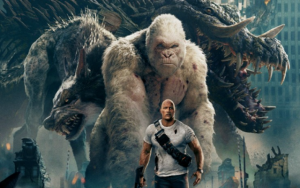They had me at ape. “Rampage,” primate power and other simian cinema.
They had me at ape. Rampage stars Dwayne Johnson as primatologist Davis Okoye along with an all-star cast, including Naomie Harris and Malin Åkerman, but for me it’s all about the ape with the unlikely name of George.
Based on the 1986 arcade game Rampage, the new film directed by Newfoundland native Brad Peyton sees a genetic experiment go horribly wrong. “We’ve created the next chapter in natural selection. Project Rampage works.” Except when it doesn’t.
George, a giant but gentle silverback gorilla, a winged wolf and a reptile are transformed into monsters with an appetite for destruction. That’s right, there’s a gorilla so big it makes The Rock and his oversized muscles look like a first grader by comparison.
Luckily Okoye raised George and they share an unbreakable bond, a connection so strong the primatologist just might be able to reason with the gorilla and put an end to the invasion of the mega-beasts.
Primate power! I go ape over simian cinema. Whether it’s the Disneynature Earth Day documentary Chimpanzee which follows the story of Oscar, an African chimpanzee born into a troop led by alpha male Freddy or the animated simian reworking of The Right Stuff called Space Chimps, I’m buying a ticket. I even enjoyed The Hangover 2 largely because of Crystal the Monkey who played a drug dealer.
Paving the way for Crystal and her primate kin was simian superstar Peggy the Chimp who appeared alongside future president Ronald Reagan in Bedtime for Bonzo. “I fought a losing battle with a scene-stealer with a built-in edge,” said the 40th President of the United States, “he was a chimpanzee!” Actually he was a she, a trained chimp who once almost strangled Reagan by mistake. The inquisitive ape grabbed the actor’s necktie and pulled it so tight the knot was “as small as my fingernail,” Reagan remembered. A quick thinking crew member cut the tie off before the Republican turned blue, setting him free to finish the cheesy movie Johnny Carson joked would become, “a favourite of old movie buffs and Democrats.”
The Tarzan movies made a superstar out of Cheetah the Chimp even though no chimpanzees appear in the Edgar Rice Burroughs novels that inspired the films. Over a dozen apes worked on the Tarzan movies and TV shows but the most famous must be Cheeta who starred in two dozen films. In 2008 he released Me Cheeta, a memoir ghostwritten by James Lever. “’I acted into my thirties,” “he” wrote. “Most chimps retire by the age of ten because they won’t do what they’re told. I didn’t want to end up in a lab with an electrode in my forehead.”
Long before computer generated special effects made digital apes like the ones featured in movies like Rampage and War for the Planet of the Apes possible, a makeup artist named John Chambers pioneered primate makeup. His work on the original Planet of the Apes was based on a technique he developed during World War II to give disfigured veterans a natural look.
The makeup process was so intense that Kim Hunter, who played chimpanzee psychologist and veterinarian Zira, had to be prescribed valium to keep her calm during the sessions. Chambers’ makeup work was extreme, but it earned him a special Academy Award his statue was presented by—who else?—a tuxedo-clad chimpanzee.

